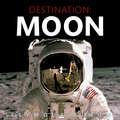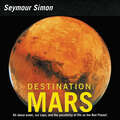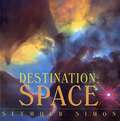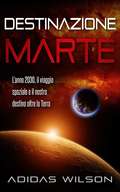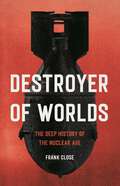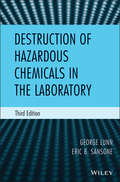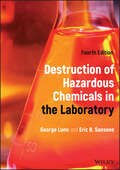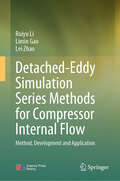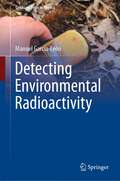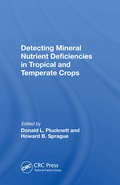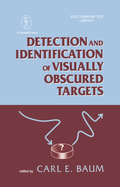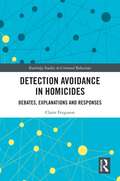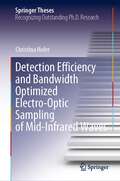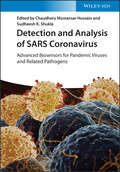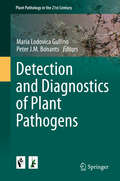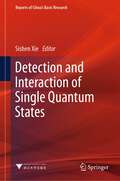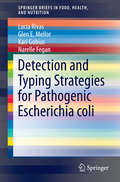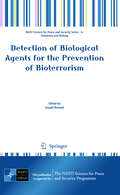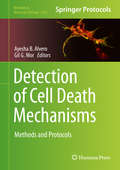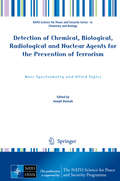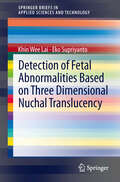- Table View
- List View
Destination: Moon
by Seymour SimonAn out-of-this-world exploration of the 1969 Moon landing from children’s science expert Seymour Simon! This nonfiction picture book is an excellent choice to share during homeschooling, in particular for children ages 6 to 8. It’s a fun way to learn to read and as a supplement for activity books for children.In July of 1969, NASA sent the Apollo 11 spacecraft to the Moon. Inside were three people: Neil Armstrong, Buzz Aldrin, and Michael Collins. They went into lunar orbit a few days later. More than a hundred hours after launch, the word came back: “The Eagle has landed!”In this exciting account of the famous 1969 Moon landing, award-winning science writer Seymour Simon tells the story of the Space Race between the US and the Soviet Union; recalls how families across the world sat captivated in front of their TVs to witness humankind’s first steps beyond Earth; and explains much of the science and technology that got our astronauts to the Moon on that remarkable day.Perfect for young scholars’ school reports, Destination: Moon features clear text, vibrantly colored pages, engaging sidebars, and stunning full-color photographs. This book includes an author's note, a glossary, a timeline, and an index and supports the Common Core State Standards.
Destination: Revised Edition
by Seymour SimonAward-winning science writer Seymour Simon explores the Red Planet through fascinating facts and amazing full-color photographs. Readers will learn about the recent discovery of water, the Valles Marineris—the biggest valley on Mars—the ice caps, recent expeditions, and more. This nonfiction picture book is an excellent choice to share during homeschooling, in particular for children ages 6 to 8. It’s a fun way to learn to read and as a supplement for activity books for children.This updated edition includes:author’s notestunning full-color photographsglossaryindexwebsites and additional reading sourcesSupports the Common Core Learning Standards, Next Generation Science Standards and the Science, Technology, Engineering, and Math (STEM) standards.
Destination: Space
by Seymour SimonExplains new discoveries about the universe made possible by the Hubble Telescope.
Destinations in Science 5
by Karen L. Ostlund Michael A. Dispezio David C. Brummett Karen K. Lind Charles R. BarmanThis book tries to introduce its readers to an exciting way of thinking about their world, discover that science is everywhere and about the real places one can find to study science like the airport, mountains and some neighbourhood destinations.
Destinazione Marte - L’anno 2030, il viaggio spaziale e il nostro destino oltre la Terra
by Adidas WilsonOggi tutti sembrano interessarsi a Marte. La NASA progetta l’invio di esseri umani su Marte per il 2030, mentre la SpaceX vuole farlo prima, nel 2024. Marte è un argomento ricorrente a Hollywood. Ci sono film, come The Martian e Life, che ipotizzano su come potrebbe essere la vita sul pianeta rosso. Tuttavia, nessuno di questi film sembra affrontare il problema fondamentale: come faranno gli esseri umani a vivere su Marte nel lungo periodo? L’atmosfera di Marte è composta, principalmente, di monossido di carbonio e la sua superficie è troppo fredda per la vita umana. La gravità è pari al 38% di quella terrestre. Di conseguenza, resta la questione di come un essere umano possa sopravvivere in un ambiente simile. Andare su Marte è facile, poiché il viaggio richiede soltanto 260 giorni quando i due pianeti sono più vicini l’uno all’altro. Dopo essere arrivati, la difficoltà è atterrare sulla superficie. Quale sistema di atterraggio è più sicuro per astronauti e coloni? Nel 2007, gli scienziati hanno proposto quattro sistemi di atterraggio: il Legged Standing System, lo Sky-Crane Landing System, l’Airbag Landing System e infine il Touchdown Sensing. Al 2017, gli scienziati hanno trovato altri metodi di atterraggio, tra cui tuffarsi nell’atmosfera marziana e costeggiare più da vicino la superficie. La NASA sta già pensando al tipo di abitazioni che aiuteranno i coloni a sopravvivere su Marte. Nel 2016, sei aziende hanno iniziato a progettare prototipi di possibili habitat. Tutti questi prototipi sono probabilmente simili sotto molti aspetti – dovrebbero essere autosufficienti, in grado di sostenere la vita per lunghi periodi senza aiuto dalla Terra ed essere a tenuta stagna per protezione dalla sottile atmosfera di Marte.
Destiny or Chance Revisited
by Stuart Ross TaylorThis exciting tour of our Universe explores our current knowledge of exoplanets and the search for another Earth-like planet. Beginning with the basic concepts of planet formation and the composition of the Universe, Stuart Ross Taylor summarises our knowledge of exoplanets, how they compare with our planets and why some stars have better habitable zones. Further sections provide a detailed study of our Solar System, as a basis for understanding exoplanetary systems, and a detailed study of the Earth as our only current example of a habitable planet. The book concludes with a philosophical and historical discussion of topics surrounding planets and the development of life, including why our chances of finding aliens on exoplanets is very low. This is an engaging and informative read for anyone interested in planetary formation and the exploration of our Universe.
Destroyer of Worlds: The Deep History of the Nuclear Age
by Frank CloseThe thrilling and terrifying seventy-year story—"kinetic, dramatic, and compulsively readable" (Patchen Barss)—of the physicists that deciphered the atom and created the hydrogen bomb Although Henri Becquerel didn&’t know it at the time, he changed history in 1896 when he left photographic plates and some uranium rocks in a drawer. The rocks emitted something that exposed the plates: it was the first documented evidence of spontaneous radioactivity. So began one of the most exciting and consequential efforts humans have ever undertaken. As Frank Close recounts in Destroyer of Worlds, scientists confronting Becquerel&’s discovery had three questions: What was this phenomenon? Could it be a source of unlimited power? And (alas), could it be a weapon? Answering them was an epic journey of discovery, with Ernest Rutherford, Enrico Fermi, Irene Joliot-Curie, and many others jockeying to decipher the dance of particles in a decaying atom. And it was a terrifying journey as well, as Edward Teller and others pressed on from creating atom bombs to hydrogen bombs so powerful that they could destroy all life on earth. The deep history of the nuclear age has never before been recounted so vividly. Centered on an extraordinary cast of characters, Destroyer of Worlds charts the course of nuclear physics from simple curiosity to potential Armageddon.
Destruction of Hazardous Chemicals in the Laboratory
by George Lunn Eric B. SansoneThe book describes practical procedures for the destruction of hazardous chemicals and biological agents in the laboratory in which they are used. The book is a continuation and expansion of "Destruction of Hazardous Chemicals in the Laboratory. " It follows the same general approach as the first and second editions but includes a number of new chapters including one on using advanced oxidation techniques as a general means of degrading chemicals. All the monographs from the second edition are incorporated in this volume and are revised and extended as necessary. A number of new monographs describing procedures for the destruction of hazardous chemicals have also been added. The destruction of many pharmaceuticals is also described in this book. This subject has become of increasing importance with recent reports of the detection of pharmaceuticals in the water supply. Finally a new addition is the chapter "General Methods for the Destruction of Hazardous Chemicals in the Laboratory. " This chapter describes recent advanced oxidation methods that should be generally applicable to all organic compounds. The methods use commonly available laboratory equipment and reagents.
Destruction of Hazardous Chemicals in the Laboratory
by George Lunn Eric B. SansoneDestruction of Hazardous Chemicals in the Laboratory Single volume reference providing procedural information for the destruction of a wide variety of hazardous chemicals Destruction of Hazardous Chemicals in the Laboratory is a practical reference that describes procedures for the destruction of a comprehensive list of hazardous chemicals and provides general methods for the destruction of hazardous chemicals in the laboratory without the need for exotic reagents and equipment. Unlike most other sources on this subject, detailed reaction parameters are provided to readers. These details will help the reader decide if a procedure will be appropriate. To further aid in reader comprehension, numerous tables throughout the book allow for ready comparison of procedures. Destruction of Hazardous Chemicals in the Laboratory also describes the critical aspects of various protocols (e.g., UV lamp type and rate of ozone flow). The updated fourth edition Includes an updated survey of the literature from 2012-2021 and features data mined from 1,500 papers. It also describes recent examples of methods that are generally applicable to organic compounds and greatly expands the section on methods for the destruction of pharmaceuticals in the laboratory. In this book, readers can expect to find detailed information on: Specific methods for the destruction of hazardous chemicals in the laboratory, such as aflatoxins, butyllithium, complex metal hydrides, ethidium bromide, MPTP, nitrosamines, and polycyclic aromatic hydrocarbons Methods for the destruction of pharmaceuticals in the laboratory, such as those using ozone, persulfate, and potassium permanganate as well as photolytic degradation procedures Procedures for drying organic solvents A discussion of the issues concerning nitrosamine formation during the destruction process, particularly when sodium hypochlorite is used A variety of indexes, including a general index, cross index of pharmaceuticals and destruction procedures, cross index of dyes and destruction procedures, and cross index of names for dyes and biological stains Destruction of Hazardous Chemicals in the Laboratory is of immense value to researchers in the laboratory by enabling them to quickly and efficiently get rid of residual amounts of hazardous chemicals when a series of experiments has ended. The procedures in the text can also be incorporated into laboratory protocols.
Detached-Eddy Simulation Series Methods for Compressor Internal Flow: Method, Development and Application
by Lei Zhao Ruiyu Li Limin GaoThis book concentrates on high-fidelity numerical methods for predicting internal flows within aeroengines’ compressors. A distinctive features of this work is the establishment of a comprehensive research framework. Specifically, it starts with engineering application requirements and integrates high-performance parallel algorithms to develop detached eddy simulation (DES)-series methods tailored to the needs of compressor design. Additionally, it encompasses the development of data analysis methods suitable for handling the "vast" amounts of high-fidelity unsteady flow data in compressors and the high spatial resolution experimental results. This book takes us from making the intricate details of compressor flow field structures "visible" to “explainable”. Another noteworthy aspect of this book is its practical orientation, seamlessly intergrating theoretical concepts with practical applications. Herein, it addresses three major engineering problems in detail and elucidates the technical approaches involving advanced numerical methods and data analysis techniques for solving these physical problems. The book highlights the challenging issues associated with complex internal flows in compressors, the governing equations for DES-series methods, and the implementation strategies for numerical simulations of internal compressor flows. They also delve into data-driven analysis methods for unsteady flow field data, high-fidelity numerical simulations of flow in the blade root region of compressors, dynamic flow capture methods in the tip region of compressor blades, and simulation and analysis of flow fields in inlet distortion generators. This book serves as a valuable reference for researchers and engineering professionals in the aerospace, computational fluid dynamics, and high-performance turbomachinery fields. Additionally, it can be used as a specialized textbook for doctoral and master's students in disciplines such as aerospace science and technology, power engineering, and engineering thermophysics.
Detecting Environmental Radioactivity (Graduate Texts in Physics)
by Manuel García-LeónThis textbook presents the principles and methods for the measurement of radioactivity in the environment. In this regard, specific low-level radiation counting and spectrometry or mass spectrometry techniques are discussed, including sources, distribution, levels and dynamics of radioactivity in nature. The author gives an accurate description of the fundamental concepts and laws of radioactivity as well as the different types of detectors and mass spectrometers needed for detection. Special attention is paid to scintillators, semiconductor detectors, and gas ionization detectors. In order to explain radiochemistry, some concepts about chemical separations are introduced as well. The book is meant for graduate and advanced undergraduate students in physics, chemistry or engineering oriented to environmental sciences, and to other disciplines where monitoring of the environment and its management is of great interest.
Detecting Mineral Nutrient Deficiencies In Tropical And Temperate Crops
by Donald L PlucknettThis book deals an essential aspect of crop management in identification of deficiencies of plant nutrients and their diagnostic methods. The book provides soil and tissue analysis standards critical in plant nutrition.
Detection And Identification Of Visually Obscured Targets
by Carl E. BaumBeginning with a review of the current need for identification of buried and surface unexplored ordnance such as mines, shells, bombs, this book then explains existing techniques for electromagnetic detection of such targets. A detailed treatment of target signatures (natural frequencies and related parameters) for identification and discrimination of false alarms is also given.
Detection Avoidance in Homicide: Debates, Explanations and Responses (Routledge Studies in Criminal Behaviour)
by Claire FergusonDetection Avoidance in Homicides: Debates, Explanations and Responses presents theory and research on how offenders avoid detection and the challenges and opportunities these efforts pose to investigators. From a scholarly perspective, the book presents a continuing history of research on detection avoidance by offenders, discusses the features of complex death investigations involving detection avoidance, and critiques the current frameworks used for conceptualizing these behaviors. Dr. Ferguson focuses on the key debates in the literature, argues for collaborations between researchers and practitioners to remedy siloing, and explores the reality of detection avoidance in homicides as complex and multifaceted. While detection avoidance behaviors have the potential to negatively impact sudden death investigations and frustrate criminal investigations specifically, their use also creates broader problems. These include many problematic effects on family members of the deceased, police officers, police agencies and the communities they serve. Offenders choosing to use detection avoidance behaviors challenges the efficient use of public resources, puts at risk the successful adjudication of homicides, and creates a public safety issue. The book explains detection avoidance using learning, situational, individual and gender-based theories, including proposing whether it may be a form of coercive control used by intimate partner abusers. Finally, how detection avoidance by offenders is recognized and responded to in sudden death investigations is addressed, with specific reference to useful examples of policy reform implemented by various police agencies internationally. Providing research and theory to explain detection avoidance and best practice for responding to it, this book will be of great interest to students and scholars of criminology, forensic science and psychology. It will also be useful to professionals working with homicide offenders.
Detection Efficiency and Bandwidth Optimized Electro-Optic Sampling of Mid-Infrared Waves (Springer Theses)
by Christina HoferThis thesis investigates the detection efficiency of field-resolved measurements of ultrashort mid-infrared waves via electro-optic sampling for the first time. Employing high-power gate pulses and phase-matched upconversion in thick nonlinear crystals, unprecedented efficiencies are achieved for octave-spanning fields in this wavelength range. In combination with state-of-the art, high-power, ultrashort mid-infrared sources, this allows to demonstrate a new regime of linear detection dynamic range for field strengths from mV/cm to MV/cm-levels. These results crucially contribute to the development of field-resolved spectrometers for early disease detection, as fundamental vibrational modes of (bio-)molecules lie in the investigated spectral range.The results are discussed and compared with previous sensitivity records for electric-field measurements and reference is made to related implementations of the described characterization technique. Including a detailed theoretical description and simulation results, the work elucidates crucial scaling laws, characteristics and limitations. The thesis will thus serve as an educational introduction to the topic of field-resolved measurements using electro-optic sampling, giving detailed instructions on simulations and experimental implementations. At the same time, it showcases the state-of-the-art in terms of detection sensitivity for characterizing mid-infrared waves.
Detection Technologies for Chemical Warfare Agents and Toxic Vapors
by Yin Sun Kwok Y. OngWhile it is not possible to predict � or necessarily prevent � terrorist incidents in which chemical warfare agents (CWAs) and toxic industrial chemicals (TICs) are deployed, correctly chosen, fast, and reliable detection equipment will allow prepared rescue workers to respond quickly and minimize potential casualties. Detection Technologies
Detection and Analysis of SARS Coronavirus: Advanced Biosensors for Pandemic Viruses and Related Pathogens
by Chaudhery Mustansar HussainThis timely reference shows how a contactless coronavirus detector may be developed using existing biosensor technology, addressing detection principles, biosensor development and fabrication as well as commericalization issues. While the book focuses on the current global research effort towards a contactless coronoavirus detector, the lessons learned can easily be applied to any other current and emerging pathogens.
Detection and Diagnostics of Plant Pathogens
by Maria Lodovica Gullino Peter J. M. BonantsThis book is part of the Plant Pathology in the 21st Century Series, started in the occasion of the IX International Congress of Plant Pathology, Torino, 2008. In conjuction with the Xth International Congress of Plant Pathology, held in Beijing in August 2013. Although deriving from a Congress, the book will not have the format of traditional Proceedings, but will be organized as a resource book It will be based on invited lectures presented at the Congress as well as by other chapters selected by the editors among offered papers. This book will cover a topic very important in the field of plant pathology, dealing with detection and diagnostics. This field of research is continuously moving forwards, due to innovation in techniques. The application of new detection and diagnostic technologies are relevant to many applied fields in agriculture. The different chapters will provide a very complete figure of the topic, from general and basic aspects to practical aspects.
Detection and Enumeration of Bacteria, Yeast, Viruses, and Protozoan in Foods and Freshwater (Methods and Protocols in Food Science)
by Marciane MagnaniThis volume details methods and procedures used to detect and enumerate bacteria in food. Chapters guide readers through food and beverage matrices, techniques used to enumerate bacteria, mixed bacterial strains (naturally present or inoculated), yeast, viruses, protozoan in distinct food matrices, and freshwater. Authoritative and cutting-edge, Detection and Enumeration of Bacteria, Yeast, Viruses, and Protozoan in Foods and Freshwater aims to provide a basic understanding on detection and enumeration of microorganisms in foods.
Detection and Interaction of Single Quantum States (Reports of China’s Basic Research)
by Sishen XieThis book highlights the findings and achievements in the major research plan “Detection and Interaction of Single Quantum States” funded by the National Natural Science Foundation of China (NSFC). The 8-year plan started in 2011 and consisted of 107 projects conducted by Chinese universities and research institutes. The book covers the plan's research background, achievements, and follow-up prospects. The plan aimed to tackle one of the major challenges for researchers worldwide—to establish precise detection and control of single quantum states in time, space, energy, and momentum. The plan integrated precise detection means with the ultrahigh resolution of time, space, and energy, under extreme conditions such as ultrahigh vacuum, ultralow temperature, high magnetic field, and ultrahigh pressure, using interdisciplinary research methods in physics, chemistry, informatics, and materials science. The book focuses on the exploration of new phenomena, theories, and concepts of single quantum states, describes new techniques and methods of single quantum states, and presents the purification and construction of single-quantum-state systems. It is a concise and valuable source of information for researchers in quantum science and graduate students interested in the research field.
Detection and Typing Strategies for Pathogenic Escherichia coli
by Lucia Rivas Glen E. Mellor Kari Gobius Narelle FeganThis Brief will review the methods that are currently available for the detection, isolation, and typing of pathogenic E. coli with a particular focus on foodborne diseases caused by the Shiga toxigenic E. coli group, which have been implicated in a number of significant outbreaks in recent years. Pathogenic forms of E. coli can cause a variety of diarrheal diseases in hosts due to the presence of specific colonization and virulence factors, and pathogenicity-associated genes, which are generally not present in other E. coli. Six pathotypes of pathogenic E. coli are recognized (Shiga toxigenic E. coli, Enteropathogenic E. coli, Enterotoxigenic E. coli, Enteroinvasive E. coli, Enteroaggregative E. coli and Diffusely Adherent E. coli) and certain strains among these groups are major public health concerns due to the severity of disease that they can cause. Methods to detect and isolate these pathogens from a variety of sources are constantly evolving. In addition, the accumulation of knowledge on these pathogens allows for improved intervention strategies.
Detection of Biological Agents for the Prevention of Bioterrorism
by Joseph BanoubThe threat of biological and chemical terrorism has driven the demand for timely techniques that can quickly detect the agent or agents used in an attack. The detection and/or prevention of these potential security threats provide significant scientific and technical challenges due to the combination of possible agents and modes of delivery available. This book will present a thorough look at the importance and technological challenges of mass spectrometry (MS) for the detection & identification of biological and chemical threats. This new contribution's general aims are to draw the attention of recognized practitioners, experts and graduate students trying to grasp the latest MS developments in the cutting-edge fields of MS-biodefense technologies for the rapid/early/specific sensitive threat detection of pathogens, viruses, explosives, mycotoxins, chemical agents, and biological markers of xenobiotic chemicals.
Detection of Cell Death Mechanisms: Methods and Protocols (Methods in Molecular Biology #2255)
by Ayesha B. Alvero Gil G. MorThis volume provides detailed protocols for the performance, analysis, and troubleshooting of in vitro and in vivo experiments related to programmed cell death. Chapters compile conventional techniques such as western blot and qPCR and state-of-the art transmission electron microscopy and real-time multiplexed imaging assays. Written in the highly successful Methods in Molecular Biology series format, chapters include introductions to their respective topics, application details for both the expert and non-expert reader, and tips on troubleshooting and avoiding known pitfalls. Authoritative and accessible, Detection of Cell Death Mechanisms: Methods and Protocols aims to ensure seamless execution of protocols on specific cell death type.
Detection of Chemical, Biological, Radiological and Nuclear Agents for the Prevention of Terrorism
by Joseph BanoubThis NATO-ASI installment is designed to provide an advanced overview for doctoral and post-doctoral candidates of the state-of-the-art technologies for bio-detection. The main objective of the work aims at providing readers with the latest developments necessary to successfully understand the CBRN Agents and their associated biotechnologies. The core methods focused on are mass spectrometry (including chromatographic and electrophoretic separation) and comparisons to spectroscopic, immunological and molecular analysis of chemical, biological and nuclear agents.
Detection of Fetal Abnormalities Based on Three Dimensional Nuchal Translucency
by Khin Wee Lai Eko SupriyantoUltrasound (US) prenatal screening has been proposed as the most effective technique for Trisomy 21 early assessment. Assessment of Nuchal Translucency (NT) offers promising non-invasive method for fetal abnormalities detection up to 75%. Nevertheless, current clinician practice of NT examination by locating the sonogram calipers on 2D US image requires highly trained and competent operators by adhering to a standard tedious protocol; therefore it is prone to errors and hence it decreases the reliability in intra- and inter-observer repeatability. This Brief provides the basic knowledge regarding Trisomy 21 diseases and its existing detection methods. The restrictions and disadvantages of each method are discussed accordingly. Therefore, a non-invasive early detection method using 3D ultrasound reconstruction of Nuchal Translucency is introduced. This new method for 3D NT assessments has an edge over the previous 2D methods, and entails the composite function in visualizing the explicit internal marker structure. Further, image processing techniques covered from data acquisition, pre-processing, speckle noise reduction and 3D segmentation are also discussed. This should be especially useful for students and professional researchers in the Biomedical and image processing fields.
